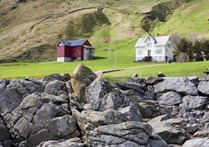Keeping Warm, Keeping Cool: Natural Ways and Unnatural Consequences
 Mary Ebbets never thought she’d want to be back in her old leaky farmhouse. It had taken her and her husband years to save up the money for a new house, and a lot more time to get the new house built on another part of their farm in Eastport, Maine. She loved her new kitchen, and she didn’t miss the drafts that seemed to suck all the heat out of the old house every winter, no matter how hard they worked to make the old furnace put out enough hot air. Now they were warm in the winter, and the new furnace worked like a charm, keeping the house warm and cozy. But there was a price.
Mary Ebbets never thought she’d want to be back in her old leaky farmhouse. It had taken her and her husband years to save up the money for a new house, and a lot more time to get the new house built on another part of their farm in Eastport, Maine. She loved her new kitchen, and she didn’t miss the drafts that seemed to suck all the heat out of the old house every winter, no matter how hard they worked to make the old furnace put out enough hot air. Now they were warm in the winter, and the new furnace worked like a charm, keeping the house warm and cozy. But there was a price.
Ever since they moved to the new house and the weather turned cold enough to shut the windows and turn on the heat, everyone kept getting sick. The children seemed to have one cold after another, colds that kept them home from school often enough so that Jimmy, her middle child, was having trouble keeping up with his class. And her husband, Joshua, had developed a cough that sometimes woke him from his sleep and worried both of them. She’d also started to have headaches, although they tended to go away when she went out. Unfortunately, with the children home so often, it was hard to get out of the house in the long winters.
In the old house, colds were rare, she realized, and decided that probably, the new house was too dry. The drafts in the old house had tended to make it a little damp, although that was mostly in the late spring, after they turned off the heat but before it was warm enough to keep the windows open. She put pans of water on most of the radiators in the new house. That seemed to help a little with the colds, but it didn’t stop Josh’s cough or her headaches.
More Common than We Think
 Mary’s story is more common that we like to think. Much of our newer housing stock has been built willy-nilly, with the builder’s economics and curb appeal as the dominating concerns rather than health and energy economy for the buyers. There’s also the issue of the bad habits American home builders have developed, so that even homes built for individual homeowners, like the Ebbets, suffer from being much less than they could have been for pretty much the same cost.
Mary’s story is more common that we like to think. Much of our newer housing stock has been built willy-nilly, with the builder’s economics and curb appeal as the dominating concerns rather than health and energy economy for the buyers. There’s also the issue of the bad habits American home builders have developed, so that even homes built for individual homeowners, like the Ebbets, suffer from being much less than they could have been for pretty much the same cost.
In most cases, it didn’t occur to the architect to specify healthy building materials and finishes and she probably left the house’s ventilation to the contractor to work out. The contractor may not have checked that his workers made sure all the work was done exactly right. The Ebbets, like most owners, would not know how to check the building for construction defects unless these became self evident – like a bathroom fan that blows into a bathroom, or an ill-fitting furnace enclosure that blows hot air wastefully into an uninsulated basement.
But there’s more to this problem than poor construction and materials. Some of our problems come from the fact that we are no longer building for climate we’re living in. We tend to build the same houses in the desert and in the bayou that we build in New England. That costs us dearly.
Native Buildings
 If you drive along the highways through the deserts of the southwest, you see tracts of houses that wouldn’t surprise you if you saw them in Massachusetts. They’re made of wood, with slanted and often shingled roofs, often with picture windows that face the view, even when the view exposes them to the full desert sun to the south or the west. Except for recent buildings where the living room has a higher ceiling as a matter of style, most of the rooms have seven- to eight-foot ceilings that keep the rising warmer air close above the occupants’ heads. The building the buildings are heavily insulated and have a large central air conditioner that runs 24/7 for most of the warmer eight months of the year.
If you drive along the highways through the deserts of the southwest, you see tracts of houses that wouldn’t surprise you if you saw them in Massachusetts. They’re made of wood, with slanted and often shingled roofs, often with picture windows that face the view, even when the view exposes them to the full desert sun to the south or the west. Except for recent buildings where the living room has a higher ceiling as a matter of style, most of the rooms have seven- to eight-foot ceilings that keep the rising warmer air close above the occupants’ heads. The building the buildings are heavily insulated and have a large central air conditioner that runs 24/7 for most of the warmer eight months of the year.
When we think “native buildings” we may think of yurts and hogans, but there was a time when all buildings were “native” to the region where they were built. When the world had fewer people, less money and no central heating or air conditioning, the house you built was the house that was traditional for your region. Wood with slanted roofs, lower ceilings and smaller windows in cold and snowy countries; thick adobe and masonry walls, flat roofs, high ceilings and latticed windows facing shaded patios in hot countries. While there were many local variations that reflected traditional forms and the materials available, hewing to the basic format for your house was a necessity. Now that we’re crowding the world and exhausting its resources, it’s a necessity we need to discover again.
We seem to have forgotten much that it would pay us to remember. For example, traditional buildings in the Middle East and the equatorial Africa, which face hot and dry conditions like those in Arizona, can be amazingly comfortable without any air conditioning at all – although with the advent of electricity, most have ceiling fans in every room. The secret is not only the thick masonry walls that provide natural insulation, but the use of the cool night air typical of desert environments. In the hot day, the doors and windows are closed and shuttered; in the cool night, they, or at least the grills and lattices that shade them, are opened.
 Not only is the building sited so that its back is to the sun, it may have one or more malqafs to catch the wind. These are towers attached to the house with openings facing the prevailing wind that is captured and allowed to blow through the house in the cool hours, cooling the walls and other surfaces to the chilly night temperature. Some houses even had a basement, or lower level which was covered with a shallow pool so that the wind captured by the malqaf would be moistened. The moist wind would move into the rooms of the house through chimneys from the basement, and lower their temperature by evaporative cooling.
Not only is the building sited so that its back is to the sun, it may have one or more malqafs to catch the wind. These are towers attached to the house with openings facing the prevailing wind that is captured and allowed to blow through the house in the cool hours, cooling the walls and other surfaces to the chilly night temperature. Some houses even had a basement, or lower level which was covered with a shallow pool so that the wind captured by the malqaf would be moistened. The moist wind would move into the rooms of the house through chimneys from the basement, and lower their temperature by evaporative cooling.
 The wooden houses of Sweden, painted dark red to absorb the limited sun; the white and pastel stucco houses in Mediterranean climates, like the houses of the Middle East, reflect their environment and use the least possible energy that they can. Until we stop insisting on bringing northern houses along when we move into southern climates, we will be in trouble. We don’t need to copy native dwellings, we just need to consider the ideas that centuries of living in a specific climate have fostered.
The wooden houses of Sweden, painted dark red to absorb the limited sun; the white and pastel stucco houses in Mediterranean climates, like the houses of the Middle East, reflect their environment and use the least possible energy that they can. Until we stop insisting on bringing northern houses along when we move into southern climates, we will be in trouble. We don’t need to copy native dwellings, we just need to consider the ideas that centuries of living in a specific climate have fostered.
 If we don’t, we’ll be like the 19th Century British explorer, John Franklin and his crew, who tried and failed to find the Northwest Passage around the top of Canada in the 19th Century. They froze and starved to death, refusing to eat raw fish and seal meat and to wear furs like the Inuit, because they considered the food and clothing of such “savages” beneath them. It was Roald Amundsen and his crew who succeeded, because they adopted Inuit practices. When he had to abandon his ice-bound ship, he was able to survive and find the way across the Canadian arctic waters from Newfoundland to Alaska.
If we don’t, we’ll be like the 19th Century British explorer, John Franklin and his crew, who tried and failed to find the Northwest Passage around the top of Canada in the 19th Century. They froze and starved to death, refusing to eat raw fish and seal meat and to wear furs like the Inuit, because they considered the food and clothing of such “savages” beneath them. It was Roald Amundsen and his crew who succeeded, because they adopted Inuit practices. When he had to abandon his ice-bound ship, he was able to survive and find the way across the Canadian arctic waters from Newfoundland to Alaska.
If we don’t change and take Amundsen’s approach, constructing buildings that relate to their environment, we’re going to find ourselves, like Franklin and his men, out of luck.


